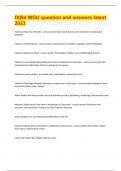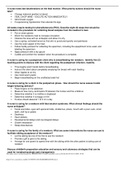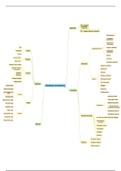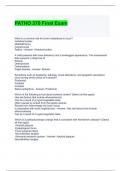Wohlwill, J. F. (1970). The emerging discipline of environmental psychology.
Main subjects:
Environmental psychology is a response to concern about quality of the environment.
Environmental psychology is problem oriented, applied, cooperating in
multidisciplinary projects.
Environmental psychology has unique potential to ask new questions.
Three forms of the interrelationship between behavior and environment:
Environment guides and limited behavior.
o Has received the most concentrated attention.
o Behavior necessarily occurs in some particular environmental context, which
limits certain behavior, and frequently serves to determine positive individual
behavior.
o Behavior and movement only occur within a given type of space.
Long term exposure to general conditions may exert generalized effects on broader
systems of response within the individual.
o Least studied subject. This cannot be studied in a controlled laboratory
experiment, because of problems related to control and isolation.
o Examples: under- or overstimulation, crowding, severity of climate.
Behavior is oriented towards the physical environment.
o Easiest to analyse and has most direct links with the most urgent and
publicized environmental problems.
o Attitudes, values, beliefs, and affective responses are often related to
individuals’ environment.
o Exhibition of temporary (e.g. tourism) and permanent (e.g. migration)
responses of approach to and avoidance or escape from given environmental
situations.
Motivational force of environmental stimulation:
Environment as a source of affect and attitudes.
o The physical environment has the power to elicit affect, ranging from pleasure
and excitement to aversion and boredom. These reactions can be subsumed
under the principles of arousal and motivation, as related to such stimulus
attributes as complexity, incongruity, novelty, variety, etc.
o Two different functions:
(1) interest or amount of voluntary exploratory activity, which increases with
complexity
(2) affective or evaluative responses, which reach an optimal value at a low or
intermediate level of complexity.
Approach and avoidance responses determined by environmental attributes.
o Includes phenomena such as moving from the inner city to the suburbs, to
migration patterns from country to city, from severe to temperate climates, etc.
, o Short-term environmental research and exploration movements may play in
the individual’s adaption to and tolerance of his permanent environmental
circumstances (such as holidays).
Adaptation to environmental qualities as a function of prolonged exposure.
o ‘Man is at once a seeker and a neutralizer of stimulation’: anything relating to
the individual’s response to his environment, once it transcends the realm of
momentary or short-term effects, inevitably leads to adaption.
o Adapting one’s affective and attitudinal responses results from a prolonged
exposure to any given environment > generally neutralizing its effects.
Adaptation level theory (Helson, 1964).
Deviation of stimuli from a pre-established adaptation level can be a
source of both positive and negative affect.
o In research, there is a much better picture of the effects of under- than of
overstimulation.
o Exposure, such as a conflict, presupposes that the individual has a realistic
choice of moving away from his present environment. However, this is not the
case for a majority of people experiencing such strains.
o Adaptation versus adjustment (Sonnenfeld, 1966):
As ways of handling discomfort and stress coming from the
environment.
People don’t only get used to environmental circumstances by
adapting, but frequently arrive at more active models of adjustment to
them. This has the effect of reducing the strain placed on our adaption
processes themselves.
This is enhanced through technological advances (such as air
conditioning). But, for example, would prolonged dependence on air
conditioning reduce one’s tolerance for extreme heats?
Challenge for psychology:
Many seemingly environmental problems, critical for our life in the cities, cannot possibly be
analysed exclusively by the physical environment. Factors of an economic, social, and
political order are also involved. We can distinguish among four primary forms that
psychology’s involvement can take:
1. Research, both basic and applied.
2. Training of and consultation with prospective and actual workers in professions
dealing with environmental problems (such as architecture and environmental
design).
3. Graduate training for psychologists.
4. The undergraduate psychology curriculum.
Prerequisites for establishment of environmental psychology as viable offspring of
our discipline
It may be suggested that environmental psychology will prosper in the environment of a
particular institution only to the extent that some of the areas are given adequate
representation and support. Much of the work in this field is situated at the boundary between
basic and applied research. There must be a receptiveness to interdisciplinary activity, to
permit effective communication and collaboration.
2
, Goldberg, T. (1969). The automobile. A social institution for adolescents.
Main subjects:
Analysis of specific environmental problems caused by conflicting sociocultural
forces.
Demonstration of relationships between sociocultural, behavioural and physical
environment.
The problem: adolescents have nowhere to go, they like cars, they take the road for
social gatherings, ‘cruising’. Their problem solving creates problems for others, such
as blocking of roads, unsafety, noise annoyance.
Characteristics of the problem:
o High sensitivity to peer group influences, activation of sexual behavior, and
rivalry.
o Cars are suitable for competition (easier than sports or intellectual
achievements) and have sexual symbolism.
o Cruising is self-sustaining, no need for other amusement facilities (just roads,
parking places, and light).
Many design and planning professionals lack a basic understanding of the social and cultural
environment (they are better at seeing the physical conceptions). But social needs are often
difficult to quantify and measure. More rational designers therefore might only select those
portions of social behavior which are easier to measure, and then overlook more significant
aspects. Rivalry functions as a mechanism for gaining status and providing desirability to the
opposite sex. For males it takes an overt competitive form, and for females it develops as a
subtle mixture of dress and social posture.
Social impact of the automobile
In the states, there are a lot of drive-in facilities. The teenager drives almost as much as the
average adult. Beginning around the age of sixteen, teenagers rapidly incorporate driving
into their lifestyle. When adolescents reach the driving age, money expended on automobiles
becomes the second largest expense.
The automobile and peer rivalry
In past generations, adolescents have grown up competing with one another through
athletics and academic achievement. Now, the automobile is also a means of competition:
drag’s racing (as the ideal adolescent display of manhood).
3








